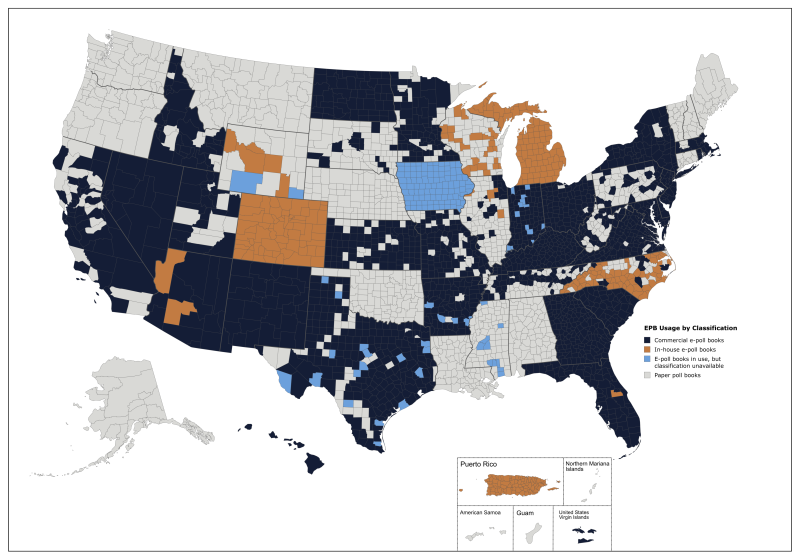Electronic Poll Book Usage Across the United States
Thanks to new questions added to the Election Administration and Voting Survey (EAVS), this is the most accurate and detailed representation of electronic poll book (EPB) usage collected to date. These data enhancements allow for clearer insights into how EPBs are being implemented across jurisdictions, including the type of system in use and its origin—commercial or in-house.
Why Tracking EPB Usage Matters
EPBs have become an increasingly vital tool in election administration. By streamlining the voter check-in process, EPBs help reduce wait times, improve accuracy, and allow for real-time updates to voter registration records—particularly beneficial during early voting and on Election Day.
As jurisdictions across the country continue to adopt EPBs, the EAC remains committed to supporting their effective implementation through the Voluntary Electronic Poll Book Certification Program (VEPBCP), which provides testing, certification, and best practices for these systems.
Want more detail? View the full spreadsheet of EPB usage here.
Growth in EPB Use
According to the 2024 Election Administration and Voting Survey (EAVS):
- 41 states and territories used electronic poll books in the 2024 general election—up from 38 in 2020
- Massachusetts adopted EPBs for the first time in 2024, rolling them out across 230 municipalities during early voting and on Election Day
- 40% of jurisdictions reported using EPBs to assist with voter check-in—the highest percentage ever reported
- EPB usage increased by more than 4% since 2022
While usage continues to rise, adoption is not yet universal. Some jurisdictions still rely exclusively on paper poll books. Usage patterns also vary based on factors like state policy, county-level decision-making, and whether a state operates under a top-down or bottom-up system architecture.
National Usage Snapshot
The map on this page shows how jurisdictions across the country are using poll book systems at the county level.
- 41.6% of jurisdictions use electronic poll books:
- 29.71% use commercial systems developed by manufacturers serving multiple jurisdictions
- 9.64% use in-house systems developed and maintained locally for exclusive use
- 2.24% use EPBs but did not identify the system or manufacturer in their EAVS response
- 58.4% of jurisdictions continue to use paper poll books.
EPB Usage by State
19 states and territories reported full (100%) EPB adoption:
Arizona, Colorado, Delaware, Florida, Georgia, Indiana, Iowa, Kentucky, Maryland, Michigan, Nevada, New Jersey, New Mexico, North Dakota, Puerto Rico, Rhode Island, South Carolina, U.S. Virgin Islands, Washington, D.C.
15 states and territories reported no EPB usage:
Alabama, Alaska, American Samoa, Connecticut, Guam, Louisiana, Maine, Montana, Nebraska, New Hampshire, Northern Mariana Islands, Oklahoma, Oregon, Vermont, Washington
EPB Usage by Manufacturer
In 2024, jurisdictions reported using EPBs from 15 different commercial manufacturers. Among these:
- KNOWiNK accounted for 61% of reported usage
- ES&S accounted for 17%
- Tenex Software Solutions accounted for 9%
In addition, 9 states or territories reported using in-house systems developed specifically for their needs. Notably, Colorado, Michigan, and Puerto Rico used in-house EPBs in 100% of jurisdictions. North Carolina and Wisconsin also reported substantial in-house usage.
Explore More
Whether you're a state official, local election administrator, or member of the public, the EAC is here to help you better understand and navigate the use of EPBs.
👉 Download the master spreadsheet of EPB usage throughout the U.S. to find out what EPB is used in your jurisdiction
👉 Visit the EPBs Evaluated at the EAC webpage to learn about federally certified EPBs
👉 Contact us at [email protected] to share feedback or request additional guidance on EPB usage
Together, we can continue to improve the security, accessibility, and efficiency of election technology nationwide.


